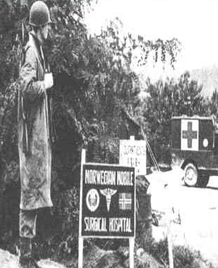 Norway
Norway
List for UN Allies
Background of Participation
After the UN Security Council had resolved to support South Korea on June 28, 1950, Norway, a non-permanent member of the UN Security Council, offered to dispatch transport ships.
Norway also planned to send a medical support unit as the UN had requested. On May 31, 1951, the Mobile Surgery Hospital composed of 83 personnel arrived in Japan where it purchased medical equipment to establish a mobile hospital with a capacity of 60 beds, personnel were trained for dealing with new equipment by US personnel. The Norwegian Mobile Hospital arrived in Korea on June 22, 1951, just before the opening of the armistice talks. It moved to Dongduchon to support the US 1st Corps directly. After being supplied with ROK and US personnel, the Norwegians opened their hospital in a temporary tent on July 19th. Norway later dispatched one hundred additional medical personnel to run the hospital independently. It also confirmed its official name as the Norwegian Mobile Army Surgical Hospital (NORMASH).
Activity of the Mobile Army Surgical Hospital
As the MASH was equipped with rooms for operation, radiation, medicine dispensation, recovering, and prescription, and with the newest medical facilities, it was a field hospital which could operate and treat all the wounded. In addition, the outpatient clinic opened at Dongduchon, treated over 600 patients a month on average. At that time, 15% of inpatients were Koreans. Among various activities of the mobile hospital, those of surgery and radiation treatments were impressive. The surgical doctors carried out 3,000 operations within one year from the opening. Only 51 died, recording less than a 1% of death rate. In total, the surgical team carried out 9,600 operations during the period of participation, 8 times a day on average. In particular, when there were fierce battles in the front, it performed 64 operations a day.
The radiation team took chest radiography for medical examinations when the front came to a lull. The team took 36,593 radiography in total, 31 a day, using 183,000 films.Until October 1954 when the NORMASH withdrew, it hospitalized 14,755 persons in total, 12,201 before the armistice, 2,554 after the armistice. Most of inpatients were South Korean, American, and British soldiers. Among inpatients, 4,317 fully recovered, and 10,288 were sent back to the rear hospitals. Only 150 inpatients died. The death rate was only 1.2%, demonstrating excellent medical talent of the Norwegian medical personnel. As the MASH began to concentrate its effort on treating civilians after the armistice, patients from all over the country, hearing of the superior medical facilities and medical talent of the hospital, came to the hospital.
The majority of the medical personnel not only extended the period of service from 1-2 years, but also visited civilian hospitals in Seoul to provide medical support during their holidays. Even after the withdrawal of the mobile hospital, Norway contributed to the medical development of South Korea by actively participating in establishing and running the National Medical Center in cooperation with Sweden and Denmark. The mobile hospital withdrew from Korea in October 1954.

